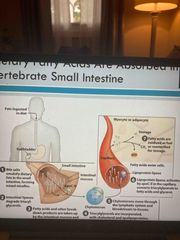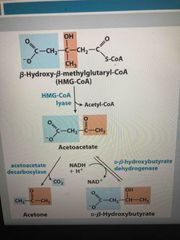![]()
![]()
![]()
Use LEFT and RIGHT arrow keys to navigate between flashcards;
Use UP and DOWN arrow keys to flip the card;
H to show hint;
A reads text to speech;
29 Cards in this Set
- Front
- Back
|
Oxidation of fatty acids source of E |
1/3 of our E comes from fats (triaglycerils) About 80% of E used for the heart and liver are from oxidation of fatty acids Hibernating animals rely on it |
|
|
Fats provide efficient fuel |
When compared with polysaccharides: Carry mor E per C Carry less water (nonpolar) Glucose and glycogen are ST w quick delivery and fats are LT w slow delivery |
|
|
Fatty acids are absorbed in the small intestines |

See pic |
|
|
Chylomicrons |

Transport lipids in blood
|
|
|
Hormones trigger movement of stored triacylglycerols |

Glucagon and epinephrine attach to receptor Adenylyl Cyclades is then g coupled to covert ATP to cAMP cAMP activated PKA PKA targets 2 proteins: hormone sensitive lipase and HSL This then activates ATGL which release a triacylglycerol, HSL breaks it doesn’t to diacylgylcerol and finally MGL redcues to monoacylglycerol so we have 3 fatty acids Fatty acids are transferred out of cell |
|
|
Lipase cleave fatty acids from glycerol |

Need a way to use both the glycerol and the fatty acids chains Glycerol will enter glycolysis |
|
|
Glycerol from fats enters glycolysis |

Glycerol kinase activate glycerol using ATP Cost is covered in next steps Allows limited anaerobic catabolism of fats |
|
|
Glycerol is then oxidized |

Glycerol 3-phosphate dehydrogenase is oxidized to create dihydroxyacetone phosphate |
|
|
Transport or attachment to phospholipids conversion to fatty acyl-CoA |

1. A phosphate from ATP is attached to prime/activate fatty acid 2. Now CoA-SH is able to bond with fatty acid and rest of phosphate group leaves Creates a fatty acyl-CoA which can be used either to build up or break down fatty acids |
|
|
Fatty acid transport into mitochondria |

Degraded in cytosol of adipose cells and then transported to other tissues for fuel Beta-oxidation of fatty acid occurs in mitochondria Less than 12C can diffuse across membrane but larger need transport via acyl-carnitine/ carnitine transporter (molecule in pic) |
|
|
Acyl-carnitine/carnitine transport |

Enzyme on outside switches out for carnitine Then goes through transport molecule (cotransporter: one goes in and one goes out). Once in mitochondria, process is reversed |
|
|
Fatty acid oxidation in mitochondria |

Stage 1: oxidative conversion of 2 C units into acetyl-CoA via beta oxidation, creating NADH and FADH2 Stage 2: oxidation of acetyl-CoA into CO2 via citric acid cycle creating NADH and FADH2 Stage 3:generates 3 ATP from NADH and FADH2 via respiratory chain |
|
|
Step 1: Beta oxidation pathway: dehydrogenation |

Remove 2 C at a time Occurs at beta C Remove 2 e- into repository chain resulting in trans double bond |
|
|
FAD cofactors in beta oxidation |

Allows for transfer of H and e- to for FADH2 |
|
|
Step 2: hydration of alkene |

Water adds across the double bond yielding alcohol on beta C |
|
|
Step 3: dehtdrogenation of alcohol |

Use another dehydranase to remove 2 e- and 2 H Use cofactors NAD+ (where e- and H are going) |
|
|
Contributions to respiratory chain |
2e- from FAD cofactors 2e- from NADH cofactors |
|
|
Step 4: transfer of fatty acid chain release |
Now have less stable structure acetyl-CoA released by thiol breaking C-C bond |
|
|
For long chain fatty acids |

Use trifunctional peptide that has all of the activities together for 12 C chains or more I’m the short chain we have separated soluble enzymes |
|
|
Oxidation of unsaturated fatty acids |

Contain cis double bonds Need additional enzymes: Isomerase coverts cis double bonds starting at C 3 to trans double bonds (need for monounsaturated) Reductase reduces cis double bonds not at C3 ( need both enzymes for polyunsaturated) The mor double bonds you introduce, the less energy you get bc step is skipped resulting in less FADH |
|
|
Odd numbered fatty acids |

Some are odd number Propionyl-CoA (3C ) forms during final cycle of beta oxidation of odd numbered fatty acids Bacteria also produces it in rumen Results in methylmalonyl CoA Needs coenzyme B12 to succinylcholine CoA (swapping H) Contains cobalt (like heme) called corrin |
|
|
Beta oxidation in peroxisomes |

Mostly in plants Same steps but Difference in location of e-, Preference for long chain FA, And NADH can not be reoxidized |
|
|
Pathway feedback |

See pic |
|
|
Omega oxidation |

Happens at omega C in ER of liver and kidney Mainly on substrates of 10 and 12 C Minor pathway but becomes important when beta oxidation cannot occur due to carnitine deficiency |
|
|
Alpha oxidation |
is used to degrade branched FA chains Occurs in peroxisomes |
|
|
Ketone bodies |
Need oxaloacetate is needed to get ACoA into citric acid cycle When it is depleted m, ACoA is converted into ketone bodies 3 different ketone bodies exist |
|
|
3 ketone bodies |
In liver Acetone: Acetoacetate Beta hydroxybutyrate |
|
|
To make ketone bodies |

1. (Reverse of last step in beta oxidation) Take 2 molecules of ACoA to make acetoacyl CoA A third ACoA is added. This frees up 2 CoA molecules to move to other tissues Break down to acetoacetate and further break down to acetone All can be used for energy purposes and if in abundance, acetone can be released |
|
|
Ketones bodies are made in kidney |

See pic |

